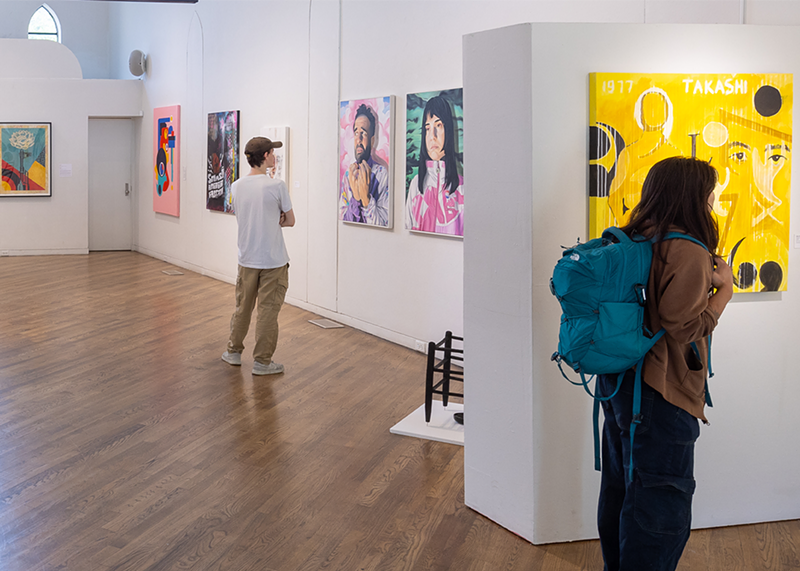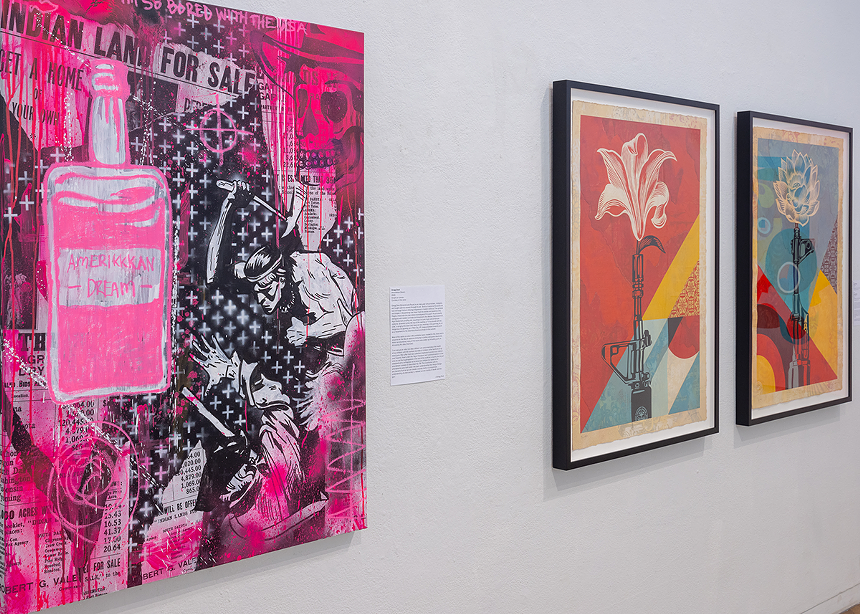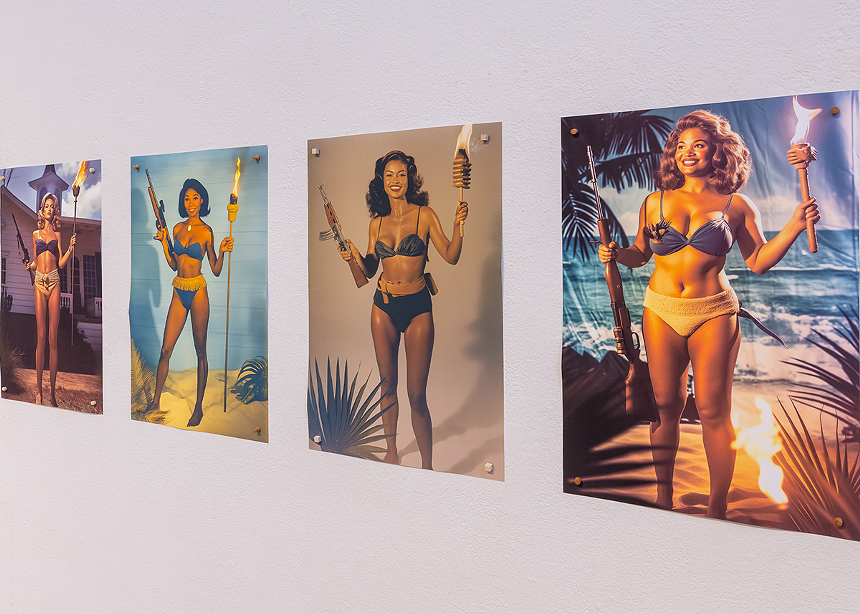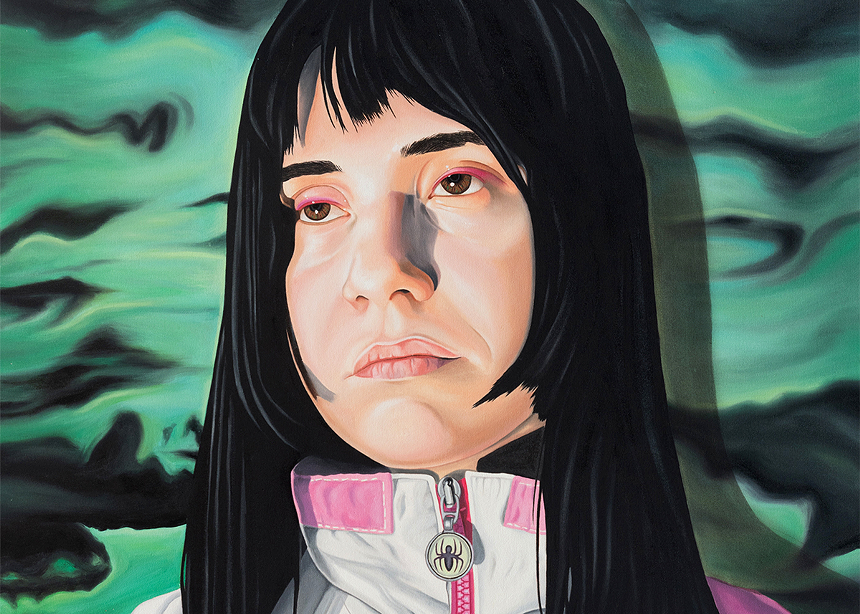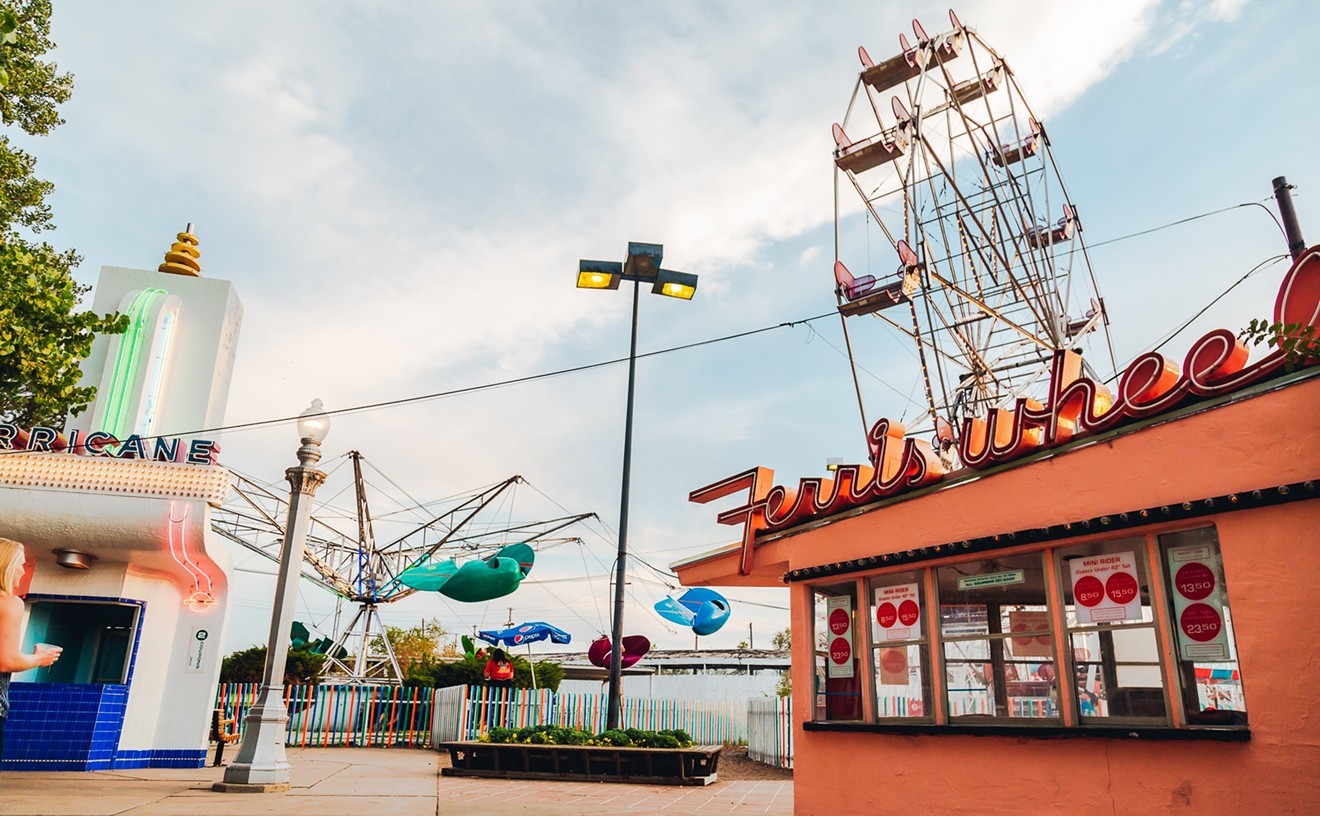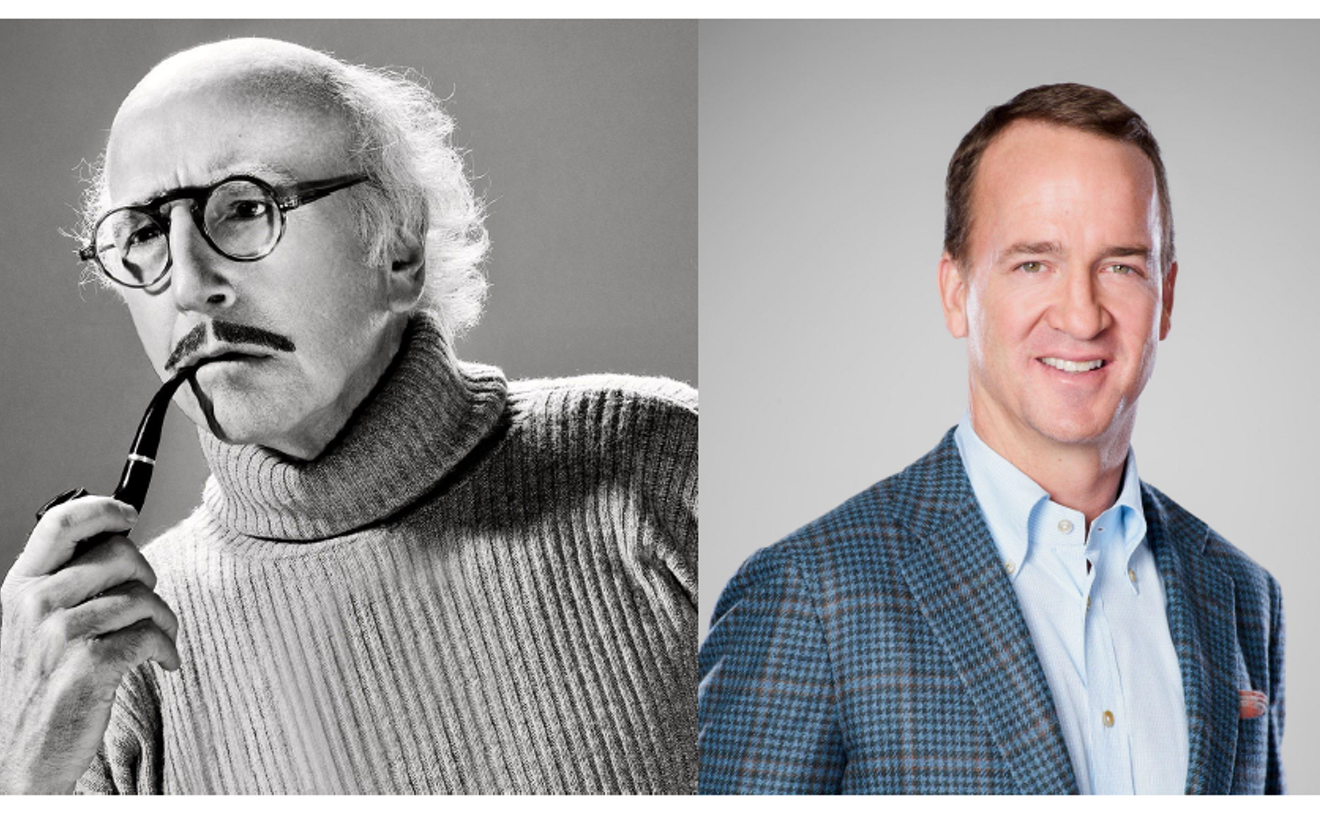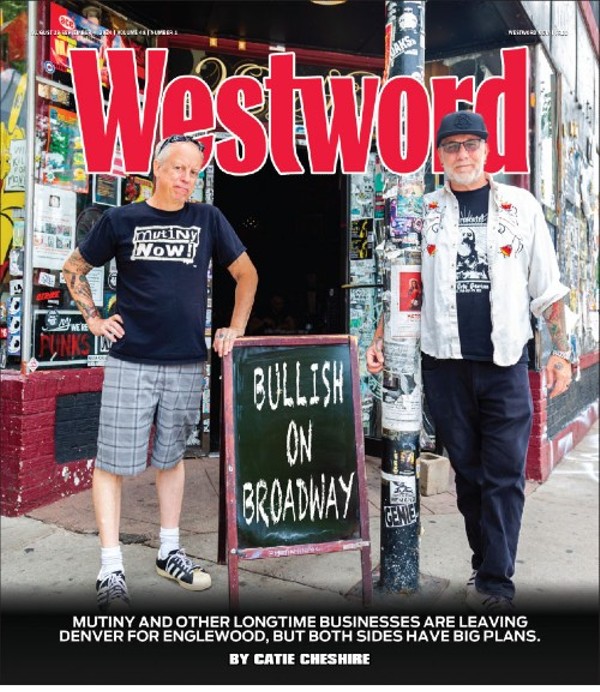Emmanuel Art Gallery is located in a small stone church on the Auraria campus. It is Denver's oldest standing religious structure, and the bustling commons around it was once the city's first neighborhood. A lone time-traveler, its companions are long gone, bulldozed to make way for the modern university that now surrounds it.
The gallery's new exhibit, Absolute Immunity, on view until November 2, kindles a very different impression. Vivid and in motion, the show is a snapshot of fears and feelings in this particular moment in time — our time. You can't wait until next year to experience it. We may not feel the same tomorrow.
The show unites an incredible collection of artists, many with Colorado connections: Gregg Deal, Ramiro Smith Estrada, Shepard Fairey, Micol Hebron, Gaby Ōshiro and Kenzie Sitterud. Their contributions follow from a simple prompt: How would you respond to the concept of "Absolute Immunity"? The term, which had already been percolating in the zeitgeist because of former president Trump's frequent citation of it, took on new meaning this year with the momentous (read: worrying) Supreme Court ruling backing him up. The show was always intended to be timely; the name had already been chosen when the SCOTUS ruling amped that up a notch.
"Instead of a show where you pick the paintings you want and create a story," explains Emmanuel's director and curator, Jeff Lambson, "we knew the artists we wanted to work with, and went to them and said, 'Here's our idea. How are you going to react to this right now?' ... These ideas are on the forefront of everyone's mind. How can artists engage with [them]?"
That eponymous idea "reads like the title of a political thriller," elaborates the exhibit's press statement. "In legal and political contexts, it can grant potentially limitless protection to those in power from legal accountability. ... But how do we set limits to limits? Who are the decision makers, and what role do we the people play in these vital systems?"
"Absolute immunity should be a beautiful concept," continues Lambson, referring to its application in a medicinal context. "Why is it that, as soon as humans get involved, it becomes associated with power and violence and class structure and oppression?"
The assembled artists attempt to answer those questions with work that is lyrical, mysterious and beautiful, though every piece has layers that inevitably lead down into "what happens when we give our leaders that much power," Lambson says. "What are the potential consequences?" Those consequences, they insist, are frequently dire.
In fact, Absolute Immunity's greatest achievement might be its delicate balancing act between light and heavy. At first glance, it is colorful and dynamic, almost bubbly — full of lush portraits and playful sculpture. Under the effervescent surface, however, dictatorships and atrocities seethe, as the show's artists repeatedly pinpoint issues where the lack of limits is a direct cause of violence.
Gregg Deal's "Amerikkkan Dream" leads the way, by taking aim at the genocidal practices that were a common feature of westward expansion, repurposing characters from an old Frank Frazetta comic, White Indian. As an ax comes crashing down on a rifle, the combatants are surrounded by advertisements for fraudulent sales of Indigenous land, a grinning skull in a cowboy hat, and the Clash title "I'm So Bored With The U.S.A." Bubblegum pink streaks splatter down over everything like spray-paint bloodstains, but at the center, ancient Paiute textile patterns peek out, untouched.
Deal, a Colorado artist who is Pyramid Lake Paiute, showed work in the Denver Art Museum's Desert Rider last year, but is also known for setting fire to the local music scene with his blistering punk-rock band, the Dead Pioneers. A multi-disciplinary disruptor, he mixes pop and other art styles, cartoons and the traditions of his people with a heavy punk influence and the unique perspective of being an Indigenous person in 21st-century America. His pieces in Absolute Immunity all skewer American identity with cheeky new contextualizations of vintage stereotypes and popular slogans, such as "Thoughts and Prayers" and "Never Surrender."
Deal is also concerned with the proliferation of guns in the U.S., especially in light of recent statistics that show firearms becoming the number-one cause of death for American kids. "I'm not just an artist, but also a father," he says in his statement for "Amerikkkan Dream." It's a concern shared by the show's other members near-unanimously, with guns cropping up throughout the exhibit in increasingly surprising and disturbing ways.
A line of AI-generated prints by Micol Hebron, for example, takes our cultural fascination with weapons out for a day at the beach. Hebron, a multi-disciplinary artist and educator, uses her work to expose sexism and gender bias in contemporary media and technology. Her "Summer Bod: Trad Wife Edition" is an uncanny set of digital portraits that display a procession of beautiful, joyful, bikini-clad women of many ethnicities, who are all carrying a tiki torch...and a semi-automatic rifle. Intrigued by the "Old Navy" aesthetics of figures such as 2020's briefly famous, gun-toting Mark and Patricia McCloskey, and the protestors at Charlottesville's "Unite the Right" rally in 2017, Hebron started the project by experimentally feeding prompts into Midjourney, a generative AI program.
"Because AI image-generating platforms have been criticized for their racial biases and stereotypes, several platforms have made an effort to integrate more 'diversity' in the output," she says. "As a result, this series presents a disconcerting mishmash of racial, cultural, religious and political positions, emphasizing just how difficult it is for AI to understand the nuances of socio-political ideology."
She contributes an even more unsettling variation on the theme with her "Infantry Diptych", an AI-generated double portrait of two young children. Their faces are turned toward us, looking creepily real, uncertain and childlike, but they are also holding handguns with a practiced grip — pointed at each other.
But the most innovative (and playful) use of firearms within the show, without a doubt, is found in Kenzie Sitterud's incredible sculpture "The War Drum." Made of gun parts, chains, bolts, drums, ice, motors, Astroturf and contact microphones, it somewhat resembles a web, woven with rifle butts and other items. Motor-driven, it clinks and clanks in the background of everything else, up on the gallery's second floor, like one of A Christmas Carol's ghosts, militarized. During the day, a block of ice is attached by a hook to its structure so that as it melts, it's dripping against a drumhead haunts the gallery monotonously.
Sitterud (who uses they/them pronouns) is a multimedia artist who concentrates on installations, design and public art. They began to practice as an artist and musician while a member of the queer/DIY scenes in both Denver and Seattle, and have been featured in many of the area's best visual art spots (Denver Art Museum, Boulder Museum of Contemporary Art, Meow Wolf, RedLine). On "The War Drum"'s meaning, they offer this simple statement: "The evolution of mankind was marked by the invention of the gun. The next evolution of humankind will be defined by its dismantling of them." Other pieces by Sitterud in Absolute Immunity include the sculpture "Movement" and the wonderful abstract painting "Untitled #11: Big Pink," which both offer tongue-in-cheek flips on Western iconography and traditional masculinity.
It isn't all barrels and triggers, though. Another, more subtle highlight (especially for lovers of plain ol' painting), with nary a pistol to be found, is the gorgeous series of portraits by Ramiro Smith Estrada, an Argentinian who has been popping in and out of the Denver scene since 2018. A connection with Lambson on his last visit led to the current one.
"When he mentioned the subject...it really connected with the pieces that I've been working on the last three years," explains Estrada. Those works, including "My dream is to become hopeless," "SERENITY NOW!" and "Surrender & Remain" have a mastery of composition and light that make them a joy to stand in front of. The figures look realistic enough to pop out of the canvas and strike up a conversation with you, and their expressions of disgust, fear and apathy suggest that the topic might be something that's come up in Absolute Immunity.
Argentina, like the U.S., is currently embroiled in turmoil, marked by the rise of populist demagogues, rising dissatisfaction on the left and rampant inflation (far worse in the case of the Latin American country). An intriguing and horrifying side note to Argentina's history comes from Gaby Ōshiro, who lives in Colorado but has roots in that country, as well as extremely personal experiences with its "disappearances" in the ’70s. Her eerie portraits of lost friends provide an underpinning to Estrada's current fears.
"Like a comic show from the ’90s in Argentina used to say, 'We are all dancing on the Titanic,'" says Estrada, who adds that his figures embody a global sense of despair that is equally relevant to both countries. "This is the conversation that I have here a lot; the fact that you only have two political parties here, for me, is very concerning. I don't feel a strong democracy is a two-party democracy: You're one party away from a dictatorship."
The near unanimous support among the U.S. and Argentinian political classes for Israel's invasion of Gaza is equally worrying to Estrada. "It's like the mask is kind of like falling off from the left, in a way. It's like, 'Oh, what the fuck do we do now?' I've heard a lot of, 'Okay, we need to vote the lesser evil.' That's what we Argentinians have been doing the last forty years!"
So, where does he find hope? "Oh, I don't [know]," he says with a laugh. "No, sorry, I don't."
But in a hopeless world, of what use is the artist? "I've always felt that maybe the role of the artist is not to take a position, but to show what's going on," he concludes. "To show the contradictions, for others to make their own decisions."
In short, one thing is certain: For questioning Denverites this season, the best place to consider those contradictions is a small stone church just west of Cherry Creek, near the place where the city began.
Absolute Immunity, through November 2, Emmanuel Art Gallery, 1205 Tenth Street Plaza. Opening reception, 4 to 7 p.m. Thursday, August 29. Admission is free.

Audio By Carbonatix
[
{
"name": "Air - MediumRectangle - Inline Content - Mobile Display Size",
"component": "12017618",
"insertPoint": "2",
"requiredCountToDisplay": "2",
"watchElement": ".fdn-content-body",
"astAdList": [
{
"adType": "rectangle",
"displayTargets": "mobile"
}
]
},{
"name": "Editor Picks",
"component": "17242653",
"insertPoint": "4",
"requiredCountToDisplay": "1",
"watchElement": ".fdn-content-body",
"astAdList": [
{
"adType": "rectangle",
"displayTargets": "desktop|tablet"
},{
"adType": "rectangle",
"displayTargets": "desktop|tablet|mobile"
}
]
},{
"name": "Inline Links",
"component": "18838239",
"insertPoint": "8th",
"startingPoint": 8,
"requiredCountToDisplay": "7",
"maxInsertions": 25
},{
"name": "Air - MediumRectangle - Combo - Inline Content",
"component": "17261320",
"insertPoint": "8th",
"startingPoint": 8,
"requiredCountToDisplay": "7",
"maxInsertions": 25,
"watchElement": ".fdn-content-body",
"astAdList": [
{
"adType": "rectangle",
"displayTargets": "desktop|tablet"
},{
"adType": "rectangle",
"displayTargets": "desktop|tablet|mobile"
}
]
},{
"name": "Inline Links",
"component": "18838239",
"insertPoint": "8th",
"startingPoint": 12,
"requiredCountToDisplay": "11",
"maxInsertions": 25
},{
"name": "Air - Leaderboard Tower - Combo - Inline Content",
"component": "17261321",
"insertPoint": "8th",
"startingPoint": 12,
"requiredCountToDisplay": "11",
"maxInsertions": 25,
"watchElement": ".fdn-content-body",
"astAdList": [
{
"adType": "leaderboardInlineContent",
"displayTargets": "desktop|tablet"
},{
"adType": "tower",
"displayTargets": "mobile"
}
]
}
]

